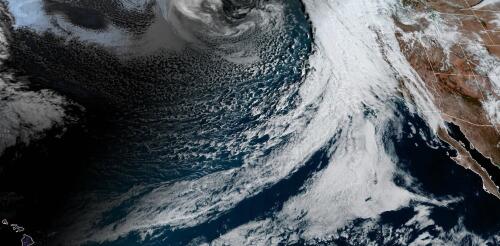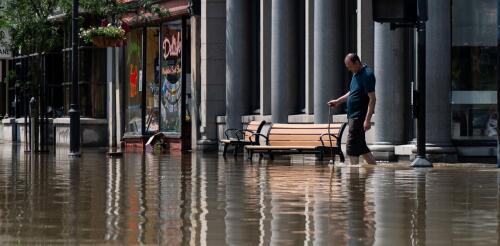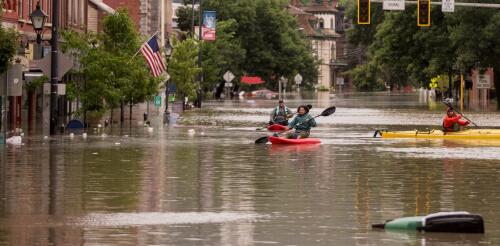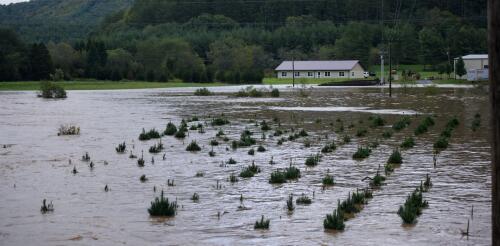Storms
Millions of Californians were under flood alerts as a powerful atmospheric river brought heavy rain to the West Coast in early February 2024. Los Angeles saw one of its wettest days on record with over 4 inches of rain on Feb. 4. Other communities were hit by more than 12 inches of rain and reported widespread flooding. Debris and mudslides shut down sections of highways and roads into Malibu. It was the latest in a series of atmospheric rivers to bring extreme rainfall to the West Coast. While these storms are dreaded for the damage they can cause, they are also essential to the region’s water supply, particularly in California, as Qian Cao, a hydrologist at the University of California, San Diego, explains. What are atmospheric rivers? An atmospheric river is a narrow corridor or filament of concentrated water vapor transported in the atmosphere. It’s like a river in the sky that can be 1,000 miles long. On average, atmospheric rivers have about twice the regul...
National weather analysts released their 2023 billion-dollar disasters list on Jan. 9, just as 2024 was getting off to a ferocious start. A blizzard was sweeping across across the Plains and Midwest, and the South and East faced flood risks from extreme downpours. The U.S. set an unwelcome record for weather and climate disasters in 2023, with 28 disasters that exceeded more than US$1 billion in damage each. While it wasn’t the most expensive year overall – the costliest years included multiple hurricane strikes – it had the highest number of billion-dollar storms, floods, droughts and fires of any year since counting began in 1980, with six more than any other year, accounting for inflation. 2023’s billion-dollar disasters. Click the image to expand. NOAA The year’s most expensive disaster started with an unprecedented heat wave that sat over Texas for weeks over...
The year 2023 was marked by extraordinary heat, wildfires and weather disasters. In the U.S., an unprecedented heat wave gripped much of Texas and the Southwest with highs well over 100 degrees Fahrenheit (37.8 Celsius) for the entire month of July. Historic rainfall in April flooded Fort Lauderdale, Florida, with 25 inches of rain in 24 hours. A wave of severe storms in July sent water pouring into cities across Vermont and New York. Another powerful system in December swept up the Atlantic coast with hurricane-like storm surge and heavy rainfall. The West Coast started and ended the year with flooding and mudslides from atmospheric rivers, and California was hit in August by a tropical storm – an extremely rare event there. Wildfires ravaged Hawaii, Louisiana and several other states. And Canada’s worst fire season on record sent thick smoke across large parts of North America. A person walks through a scene of destructio...
Hurricane Helene caused deadly and destructive flooding when it swept through the Southeast on Sept. 26-29, 2024. Across a broad swath of western North Carolina, where the worst flooding occurred, the amount of rainfall exceeded levels that would be expected on average only once every 1,000 years. But this wasn’t the first 1,000-year rainstorm in North Carolina this year. In mid-September, an unnamed slow-moving storm produced more than a foot of rainfall closer to the Atlantic coast. This storm inundated areas that had already been drenched by Tropical Storm Debby in August. As atmospheric scientists and state climatologists, we believe it’s important for the public to understand the risk that extreme events may occur. That’s especially true as climate change alters the conditions that create and feed storms. Here’s how scientists calculate storm probabilities, and why events like a 1,000-year storm can happen much more frequently in some places than tha...
Hurricane Helene cut power to more than 4 million homes and businesses as it moved across the Southeast after hitting Florida’s Big Bend region as a powerful Category 4 storm on Sept. 26, 2024. As Helene’s rains moved into the mountains, causing devastating flooding, officials warned that fixing downed utility lines and restoring power would take days to weeks. Electricity is essential to just about everyone – rich and poor, old and young. Yet, when severe storms strike, socioeconomically disadvantaged communities often wait longest to recover. That isn’t just a perception. We analyzed data from over 15 million consumers in 588 U.S. counties who lost power when hurricanes made landfall between January 2017 and October 2020. The results show that poorer communities did indeed wait longer for the lights to go back on. A 10 percentile drop in socioeconomic status in the Centers for Disease Control and Prevention’s social vulnerability index was assoc...




